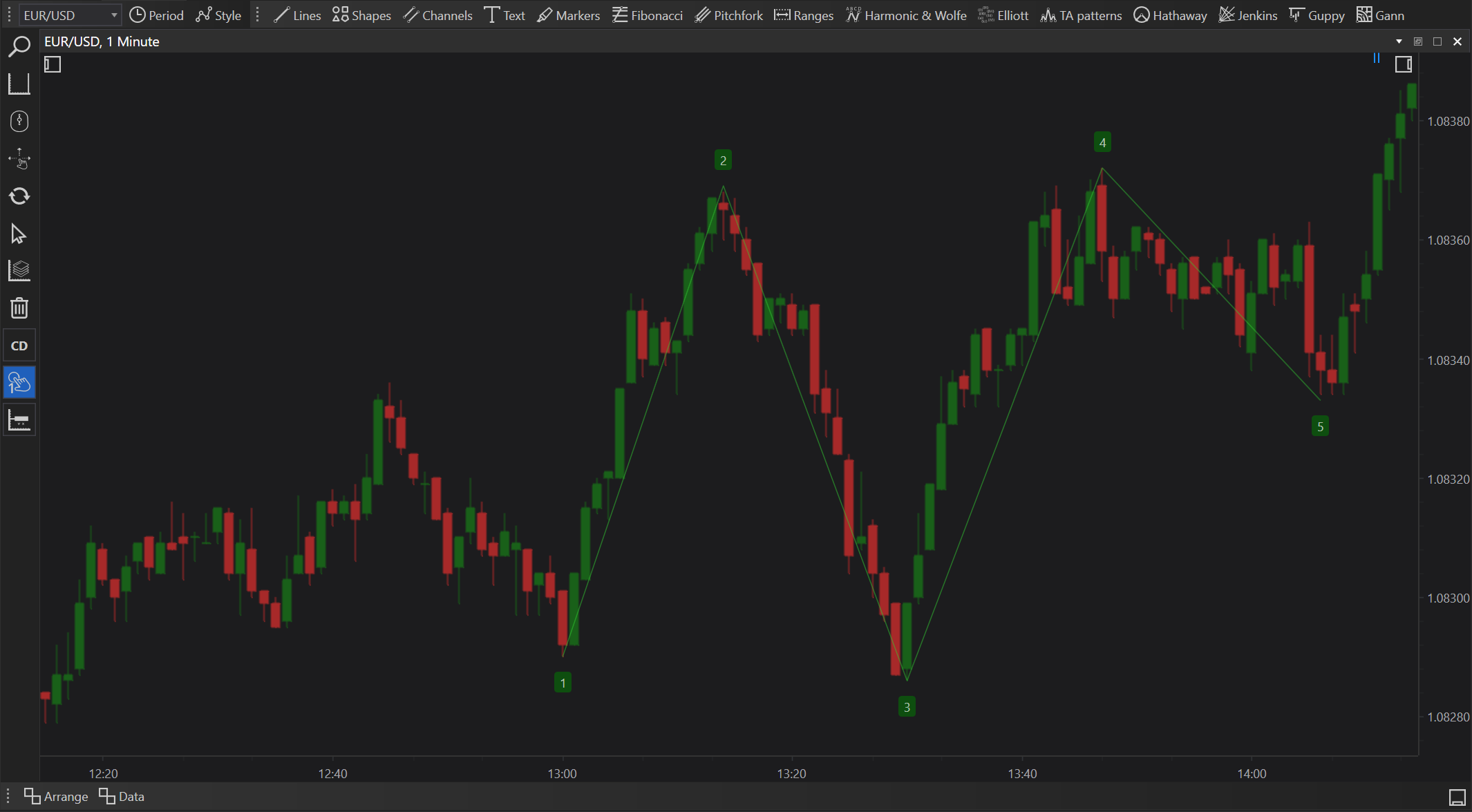- Accounts & Connection Management
- Data Management & Analysis
- Price Monitoring
- Charting
- Trading
- Scanners
-
Builders
-
Manual Strategy Builder
- Main Concept
- Operand Component
- Algo Elements
-
Use Cases
- How to create a condition on something crossing something
- How to create an indicator based on another indicator
- How to calculate a stop loss based on indicator
- How to submit stop order based on calculated price
- How to calculate a current bar price using a price type from inputs
- How to Use a Closed Bar Price
- Automatic Strategy Builder
-
Manual Strategy Builder
- Autotrading
- FinScript
- Trade Analysis
- Media Feeds
- Logs & Notifications
- UI & UX
Overview of Impulse Waves Tools
In FinStudio, the Impulse Waves tools are designed to analyze and map out the primary driving phases of market trends. These tools, central to Elliott Wave Theory, identify the sequences of moves that push the market directionally, which are typically interspersed with smaller corrective waves. Impulse Waves are critical for traders aiming to capitalize on the main trends within various financial markets.

Types of Impulse Waves Tools and Their Uses
Impulse Sequence: 1 2 3 4 5
- Application: This sequence is used to identify the structure of a strong directional move within a market trend. The waves numbered 1, 3, and 5 are motive, meaning they move in the direction of the overall trend, while waves 2 and 4 are corrective, moving against the trend.
- Functionality: The tool allows traders to predict continuation points and potential reversal points after corrections, providing a roadmap for trading within the trend.
Practical Applications
-
Trend Trading:
- Use: Traders utilize the Impulse Waves sequence to align their trades with the primary market trend, entering during the early stages of motive waves and considering exits or profit-taking during corrective phases.
- Benefit: Enhances profitability by allowing traders to ride the wave of the market momentum, ensuring positions are in harmony with the main directional moves.
-
Market Entry and Exit Points:
- Use: Identifies precise entry and exit points by recognizing the start of new impulse waves or the end of corrective waves.
- Benefit: Improves trade accuracy by providing clear indicators of when the market momentum is likely to continue or pause, which is essential for timing market entries and exits effectively.
-
Risk Management:
- Use: Facilitates the setting of strategic stop-loss orders below or above key corrective waves to protect gains or limit losses.
- Benefit: Helps manage risk by leveraging the natural ebb and flow of the market's wave structure, providing logical points for risk containment based on established wave patterns.
Benefits
- Enhanced Market Insight: Offers a deeper understanding of the market's natural rhythm and structure, allowing traders to anticipate moves rather than react to them.
- Strategic Trade Optimization: By identifying the phases of impulse and correction, traders can optimize their strategies to maximize gains during strong trends and minimize losses during retracements.
- Educational Value: Provides traders with a practical framework for applying Elliott Wave Theory, enhancing their analytical skills and understanding of market psychology.
Conclusion
The Impulse Waves tools in FinStudio are invaluable for traders who focus on trend following and want to capitalize on the primary movements of the markets. By accurately charting the impulse sequences, traders can make informed decisions, aligning their trading strategies with the powerful waves that define market trends. These tools not only aid in identifying when to trade but also offer insights on when it might be prudent to step aside, thus enhancing both the effectiveness and efficiency of trading operations. Whether for day trading, swing trading, or long-term trend following, the Impulse Waves provide a critical advantage by elucidating the core dynamics of market movements.
- Accounts & Connection Management
- Data Management & Analysis
- Price Monitoring
- Charting
- Trading
- Scanners
-
Builders
-
Manual Strategy Builder
- Main Concept
- Operand Component
- Algo Elements
-
Use Cases
- How to create a condition on something crossing something
- How to create an indicator based on another indicator
- How to calculate a stop loss based on indicator
- How to submit stop order based on calculated price
- How to calculate a current bar price using a price type from inputs
- How to Use a Closed Bar Price
- Automatic Strategy Builder
-
Manual Strategy Builder
- Autotrading
- FinScript
- Trade Analysis
- Media Feeds
- Logs & Notifications
- UI & UX